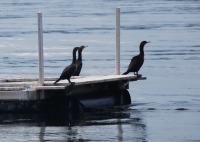
(Photo: Tracey Dean)
Double-Crested Cormorant
Phalacrocorax auritus
This cormorant has black or dark brown plumage with a greenish or bronze gloss. It has distinctive orange-yellow skin on its throat and face, and bright blue eyes. It is typically 70 to 90 centimetres long and weighing up to 2.5 kilograms. Its double crest is only fully developed early in the year, so is not very useful for identification.
Authority
Lesson, 1831
Classification Details
Phylum: Chordata (chordates); Subphylum: Vertebrata (vertebrates); Class: Aves (birds).
Habitat
Present all over North America, from Alaska to Mexico in the west and Newfoundland to the Caribbean in the east. It is found around seacoasts and near inland waters. Birds may stay in areas year-round or migrate to different locations to breed.
Diet
Predator. Eats fish, mainly schooling or slow-moving species. Prey are usually under 15 centimetres long. Feeds in shallow water (less than 10 metres deep) close to shore. It dives from the surface and pursues its prey underwater. It has a hook-like nail at the tip of its upper bill, which helps it grasp its prey.
Reproduction
Males court females to attract a mate. After pairing, both birds build a nest. The male brings the materials, and the female guards them from thieves and constructs the nest. Nests can be on the ground or in trees. Birds often re-use nests for several years, and ground nests may reach up to two metres in height. Females lay a clutch of between one and seven eggs. Parents take turns incubating the eggs until they hatch after 25 to 28 days. Parents brood the chicks for 12 to 15 days and feed them until they leave the nest at 3 to 4 weeks if raised in ground nests, and 6 to 8 weeks if raised in tree nests (tree nest chicks have to be able to fly to leave). After leaving the nest, fledgelings gather with other young cormorants from the colony in nurseries. This species often lives for over 8 years; the oldest recorded bird was 22 years and 6 months old.
Fun Facts
Cormorants get creative when building their nests. Along with twigs and seaweed, they incorporate marine debris, such as rope, buoys and even dead birds. Scientists found 37% of nests in the Gulf of Maine contained plastic debris.
On hot days, chicks water beg. This differs from food begging as they open their bill wide rather than keeping it closed. Parents bring water and pour it into their bill.
References
Dorr BS, Hatch JJ and Weseloh DV (2020). Double-crested Cormorant (Phalacrocorax auritus), version 1.0. In Birds of the World (A. F. Poole, Editor). Cornell Lab of Ornithology, Ithaca, NY, USA. https://doi.org/10.2173/bow.doccor.01 Podolsky RH and Kress SW (1989). Plastic debris incorporated into Double-crested Cormorant nests in the Gulf of Maine. Journal of Field Ornithology 60, 248-250. Van Tets GF (1959). A comparative study of the reproductive behaviour and natural history of three sympatric species of cormorants, (Phalacrocorax auritus, P. penicillatus, & P. pelagicus) at Mandarte Island, B.C. Master's Thesis, University of British Columbia, Vancouver.

